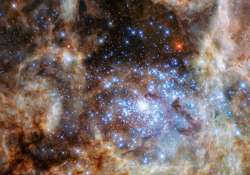Scientists discover group of stars 100 times larger than Sun
NASA/ESA Hubble Space Telescope, an international team of scientists has identified nine monster stars with masses over 100 times that of our Sun in the star cluster located about 170,000 light-years away. The discovery is the largest sample of very

London: NASA/ESA Hubble Space Telescope, an international team of scientists has identified nine monster stars with masses over 100 times that of our Sun in the star cluster located about 170,000 light-years away. The discovery is the largest sample of very massive stars identified to date, researchers said.
Scientists using the unique ultraviolet (UV) capabilities of Hubble combined images taken with the Wide Field Camera 3 with the unprecedented UV spatial resolution of the Space Telescope Imaging Spectrograph (STIS) to successfully dissect the young star cluster R136 in the ultraviolet for the first time.
R136 is only a few light-years across and is located in the Tarantula Nebula within the Large Magellanic Cloud, about 170,000 light-years away.
The young cluster hosts many extremely massive, hot and luminous stars whose energy is mostly radiated in the UV.
The researchers found dozens of stars exceeding 50 solar masses, as well as nine very massive stars in the cluster, all more than 100 times more massive as the Sun.
However, the current record holder R136a1 does keep its place as the most massive star known in the universe, at over 250 solar masses, researchers said.
The detected stars are not only extremely massive, but also extremely bright. Together these nine stars outshine the Sun by a factor of 30 million.
The scientists were also able to study outflows from these behemoths, which are most readily studied in the ultraviolet.
They eject up to an Earth mass of material per month at a speed approaching one per cent of the speed of light, resulting in extreme weight loss throughout their brief lives.
“The ability to distinguish ultraviolet light from such an exceptionally crowded region into its component parts, resolving the signatures of individual stars, was only made possible with the instruments aboard Hubble,” said lead author Paul Crowther from the University of Sheffield in the U.K.
The results gathered from R136 and from other clusters also raise many new questions about the formation of massive stars as the origin of these behemoths remains unclear.
“There have been suggestions that these monsters result from the merger of less extreme stars in close binary systems,” said Saida Caballero-Nieves, from University of Sheffield.
“From what we know about the frequency of massive mergers, this scenario can’t account for all the really massive stars that we see in R136, so it would appear that such stars can originate from the star formation process,” she said.
An analysis of new optical STIS observations will also allow them to search for close binary systems in R136, which could produce massive black hole binaries which would ultimately merge, producing gravitational waves.
The research appears in the journal Monthly Notices of the Royal Astronomical Society.